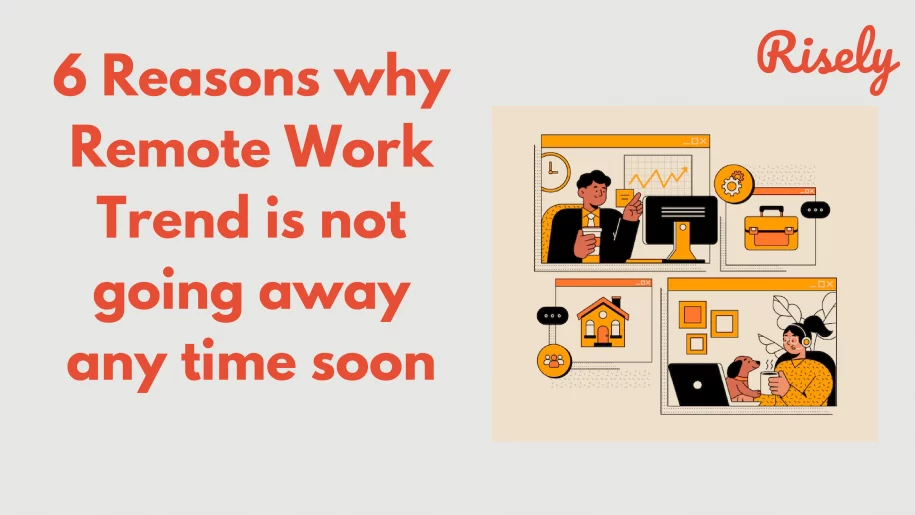6 Reasons why Remote Work Trend is not going away any time soon
The pandemic has changed how we work; remote work is here to stay. For many companies, it has been an excellent way to keep business running while keeping employees safe. In this blog post, we will explore if remote work is a trend that will stick around and if it’s going away anytime soon. Next, we will discuss the benefits of remote work and the challenges of remote work. Finally, we will look at remote work trends for 2023 and beyond and remote work future trends.Benefits of remote work
Remote work trend, or working from a location other than a traditional office setting, offers several benefits:- Increased flexibility: Remote work gives employees more control over their schedules and work-life balance. They can choose when and where to work, accommodating personal obligations and preferences.
- Elimination of commuting: Remote work eliminates the need for daily commuting, saving valuable time and reducing traffic or public transportation stress. This also leads to cost savings on transportation expenses.
- Enhanced productivity: Many remote workers report higher productivity levels due to fewer distractions and interruptions than in a traditional office environment. They have the freedom to create an ideal workspace and choose optimal conditions for concentration.
- Increased job satisfaction: Remote work often leads to higher job satisfaction, providing employees more autonomy and flexibility. This can result in improved morale, motivation, and loyalty to the company.
- Reduced environmental impact: With remote work, there is a decrease in commuting and office-related energy consumption, resulting in a reduced carbon footprint. This contributes to sustainability efforts and environmental preservation.
- Improved work-life balance: Remote work trend allows employees to integrate their personal and professional lives better. They can spend more time with family, pursue hobbies, and engage in activities that promote their well-being.
- Accessible employment opportunities: Remote work offers increased accessibility for individuals with disabilities or those facing physical limitations. It provides equal employment opportunities and promotes inclusivity in the workforce.
Challenges of remote work
Remote work, despite its many advantages, also presents several challenges. Here are some key challenges associated with remote work:- Communication: Remote teams often face communication hurdles due to the absence of face-to-face interactions. Misunderstandings, delayed responses, and difficulties conveying tone and context can hinder effective collaboration.
- Collaboration and Teamwork: Collaborating on projects and fostering a sense of teamwork can be more challenging in a remote work environment. A lack of spontaneous brainstorming sessions and informal interactions can impede innovation and creative problem-solving.
- Work-Life Balance: Remote work trend has blurred the boundaries between professional and personal life, making it harder for individuals to separate work and personal time. This can lead to longer work hours, increased stress, and a potential decline in overall well-being.
- Distractions and Productivity: Working from home can expose employees to various distractions, such as household chores, family members, or a less-than-ideal workspace. Maintaining focus and productivity in such environments can be difficult for some individuals.
- Isolation and Loneliness: Remote work can lead to isolation and loneliness, as employees lack social interactions and camaraderie in traditional office settings. This can affect motivation, job satisfaction, and mental health.
- Technology Challenges: Dependence on technology for remote work means that technical issues, such as connectivity problems or software glitches, can disrupt workflow and hinder productivity. A lack of IT support on hand can exacerbate these challenges.
- Professional Development: Remote work may limit opportunities for professional development, mentoring, and networking, as employees have fewer chances for in-person training, career guidance, and informal learning experiences.
Other Interesting Reads
Is remote work going away?
No, remote work is not going away anytime soon. While the future of work may involve a mix of remote and in-person arrangements, remote work is expected to remain a significant part of the work landscape. The COVID-19 pandemic accelerated the adoption of remote work and highlighted its benefits, leading many companies to incorporate remote work options into their long-term strategies. Here are some reasons why remote work is likely to continue:- Employee preferences: Many employees have experienced the advantages of remote work, such as increased flexibility and improved work-life balance. As a result, they may seek opportunities that offer remote work options, and companies will need to accommodate these preferences to attract and retain top talent.
- Talent acquisition: Remote work trend has allowed companies to access a global talent pool, allowing them to hire the best candidates regardless of location. In a competitive job market, offering remote work can be a strategic advantage in attracting highly skilled professionals.
- Cost savings: Remote work provides cost-saving opportunities to both companies and employees. Businesses can reduce office space, utilities, and equipment expenses, while employees can save on commuting costs and work-related expenses.
- Technology advancements: Technology advancements have made remote work more feasible and productive. Communication and collaboration tools have improved, enabling effective virtual teamwork and seamless remote operations.
- Business continuity: Remote work provides a backup plan during unforeseen disruptions, such as natural disasters or public health emergencies. Companies have recognized the importance of flexible work arrangements to ensure business continuity.
- Sustainability and environmental considerations: Remote work trend reduces carbon footprints by minimizing commuting and office-related energy consumption. Organizations and individuals increasingly prioritize environmental sustainability, making remote work appealing.
Remote work trends for 2023
With the trend towards remote work likely to continue, we can expect several changes and innovations in how we work. Regardless of what the future holds, it’s clear that remote work is here to stay, and organizations of all kinds will need to adapt if they want to remain competitive in an increasingly globalized and interconnected world. Here are some potential trends that could emerge in 2023:- Hybrid Work Models: Many organizations will likely adopt hybrid work models combining remote and in-person work. This approach allows employees to work from home part of the time while also coming into the office for certain activities, fostering a flexible work environment.
- Enhanced Remote Collaboration Tools: With the increasing reliance on remote work, there will be a continued focus on developing and improving collaboration tools. Expect advancements in virtual meeting platforms, project management software, and other tools that facilitate remote teamwork and communication.
- Remote Onboarding and Training: As remote work trend becomes more prevalent, companies will invest in refining their onboarding and training processes to effectively integrate new hires into virtual work environments. Virtual training programs, mentorship opportunities, and comprehensive onboarding materials will become more common.
- Emphasis on Work-Life Balance: Employers will recognize the importance of work-life balance for remote workers and take steps to promote employee well-being. This may include implementing flexible work hours, encouraging breaks and time off, and providing resources for mental health support.
- Cybersecurity Measures: With the increase in remote work, cybersecurity threats will likely become more sophisticated. Organizations will prioritize implementing robust cybersecurity measures to protect sensitive data and ensure the security of remote work setups.
- Remote Team Building and Employee Engagement: Companies will seek innovative ways to foster team cohesion and maintain employee engagement in remote settings. Virtual team-building activities, online social events, and opportunities for casual interactions will become integral parts of remote work cultures.
Remote Work Future Trends
As we move toward the future, it’s clear that remote work is not just a temporary solution to the pandemic. The trend is here to stay, and many experts predict that remote work will become a permanent feature of the modern workplace. The future of remote work is expected to witness continued technological advancements, enabling seamless virtual collaboration and communication. We can anticipate the rise of virtual and augmented reality tools that create immersive remote work environments, fostering stronger connections among distributed teams. Additionally, flexible work arrangements and remote job opportunities are likely to become more widespread, attracting top talent worldwide and transforming the traditional workplace concept as organizations prioritize flexibility and work-life integration. While this shift presents new challenges for employers and employees, it also offers exciting possibilities for innovation and collaboration in the coming years.Conclusion
Remote work has gained popularity over the years and has become even more prevalent due to the pandemic. The benefits of remote work include increased productivity, flexibility, and cost savings for both employees and employers. However, there are challenges, such as communication barriers and lack of social interaction. Despite these challenges, remote work is here to stay as businesses adapt to the changing workforce landscape. Research shows that remote work trends will continue to grow in 2023 and beyond, emphasizing hybrid work models. Therefore, keeping up with future remote work trends is essential to stay ahead of the curve. Learn more about the future of remote work by reading our comprehensive blog on remote work trends.Learn to set the right priorities in remote working environments to create balance in life.
Get started on this journey of mindfulness and growth with a free assessment of your prioritization skills.
Frequently Asked Questions
What is the future of remote work?
The future of remote work is bright, with many experts predicting that it will become a permanent feature of the modern workplace. While there are also challenges to consider, businesses adapt to the changing workforce landscape and embrace new policies and procedures to manage remote workers effectively. Research on remote work trends will continue to grow in 2023 and beyond, emphasizing hybrid work models. Stay ahead of the curve by keeping up with future remote work trends.
Is remote work a new concept?
No, remote work has been around for decades, but it has become more prevalent in recent years due to advances in technology and changes in the workforce landscape. However, the COVID-19 pandemic has accelerated its adoption and made it a more widespread concept.
Is remote work the new normal?
Remote work is becoming more normalized, but whether it becomes the “new normal” remains to be seen. Many businesses are adopting hybrid work models that offer their employees in-person and remote work options. As the workforce continues to evolve, remote work will likely remain a prominent feature of the modern workplace.
Other Related Blogs
How To Motivate Remote Employees In Your Team?
How To Motivate Remote Employees In Your Team? Teams worldwide are adapting to new working styles, and a remote setup is no longer uncharted territory for many organizations. In fact,…
How to identify and beat the 10 common challenges of remote work?
How to identify and beat the 10 common challenges of remote work? As work moves increasingly out of the office and into remote work environments, the challenges facing remote team…
The Role Of Overcommunication At Work With 3 Examples: Is It Good Or Bad?
Communication is the foundation of any successful workplace. It helps to build trust, create a positive company culture, and foster collaboration. Overcommunication, in particular, has become increasingly important in today’s…
7 Best Practices For Making Virtual One On One Meetings Effective
7 Best Practices For Making Virtual One On One Meetings Effective Are you tired of never-ending email chains and miscommunications within your team? Have you ever found yourself struggling to…


